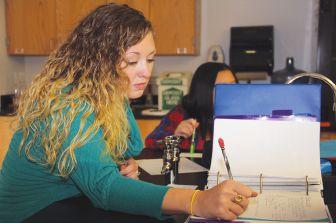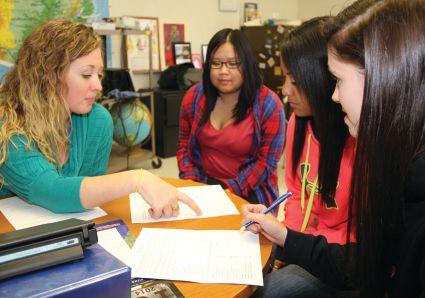
5 minute read
Walking In Her Shoes
Walking in Her Shoes A day in the life of an Ed Tech III
7:20 a.m.

Ed Tech III Lindsey Morin takes notes and does all the math worksheets so she can grasp the material herself in order to help her student. By mid-year the student is learning well and Morin answers questions when asked.
9:15 a.m.
Classroom Teacher: What is happening during the freezing process? Cindy Whispers: Kinetic energy. Morin: Yeah! Say it louder! You totally got it. Trust yourself. You have the right answers.
Morin is a constant source of encouragement for her Special Education Students who need both learning and support. “She helps me with my work. She’s cool, nice and friendly,” says Cindy. Do you remember what particles are? Cindy isn’t sure so Morin turns back to the notes she took from the last class. Yes, she keeps detailed notes, arranged neatly in a binder. She has one for each subject.
9:42 a.m.
“Ready to work magic?” Morin asks Cindy as they both put on protective goggles for an in-class experiment. While they appear to look like lab partners, Morin is much more, guiding Cindy to examine the chemical reactions and analyze the data. Morin didn’t study chemistry as part of her formal college education but like Cindy, she is a good student and uses her love of learning to help Cindy succeed. Y ou really need sneakers to keep up with Lindsey Morin who is in her 10th year as a Special Education Ed Tech III at Cony High School in Augusta. On her way to meet her assigned students, in the pre-vocational program, she hands out high-fi ves in the hall. She’s fast. And it’s clear she’s needed.
“If our kids don’t have anyone in the classes—it’s brutal—it’s the diff erence between sink or swim,” said Morin, Augusta Education Association. The increased need for special education ed techs keeps Morin and the one other ed tech in the program more than busy. Cuts reduced the level of staffi ng over the years so students are now grouped together to make sure each child gets the attention required. “We want them to be as successful in the mainstream as possible, empowering themselves by good choices and hard work; that’s our goal,” said Morin.
10:28 a.m.
On her way to her next class, Morin stops to ask a student she doesn’t work with how things are going. She has a continued interest in all the students she meets, which is clear as the walk from one side of the school to the other is filled with “hellos” and friendly waves.

There are 67 ed techs in the Augusta school district compared to 170 teachers, representing 40% of the overall teaching staff . Superintendent James Anastasio says ed techs play an important and indispensable role in the educational process. “The direct instruction and support they provide for students and teachers are essential. Without their support, many students would not have their needs met and teachers would fi nd it almost impossible to provide the attention, instruction, and individualized intervention and/or rigor that all students deserve.”
Morin is grateful for the support from administrators and students. “It’s really nice to know you’re appreciated; you feel validated,” says Morin, as she hustles her way down the hall for what will be another busy day.
10:30 a.m.
From Tech Chemistry to Global Insights Morin quickly switches gears and joins a round table discussion about current events helping two students engage in the conversation. This class is particularly hard, none of the students are very talkative and Morin knows she needs to find a way to break through.
2:15 p.m.
Morin gets ready to go home. “The best feeling about my job is our students who make it a point to come tell me how they are doing. It’s nice to know the kids trust you and know you’re invested in them.”
1:50 p.m.

Morin’s student day ends but her work is not complete. She heads back to the central classroom where all the Special Education Students meet for the day and posts assigned work as she reports back to the lead teacher, Tammy Roberts (Augusta EA). “Lindsey understands the balances of support and need. She has a lot of the innate things you can’t teach that motivate the kids and really makes the staff happy to work with her,” said Roberts.
1:15 p.m.

Half way through class, Morin finds her table, where she pulls her students aside, has grown by two more students who are not in special education. She is now helping those students as well teaching them life lessons that are relevant to all students. “We share a lot of hopes and we want to encourage hope but we like to teach them if you want to be a doctor, what does it really take?” said Morin.
In addition to the notes she takes in each class, Morin also makes copies of all handouts so come test time each student can use her work to study and prepare.
12:30 p.m.
“When I was in high school I was terrible in math but now I’m relearning it so I can help them,” said Morin as she worked with two more students in Life Skills. It’s a needed lesson in this class as Morin teaches her Special Education Students how to calculate the taxes in a paycheck.
11:20 a.m.
Morin probes her students with questions about an assignment to analyze a political cartoon. While she is only assigned two students in the class she ends up helping others as well. “I’ve worked with Lindsey for a number of years. She is really good at drawing the kids out and that’s what’s important because we’re trying to get them to be critical thinkers. She’s a good facilitator,” said Jon Millett, Social Studies teacher. Augusta EA.









